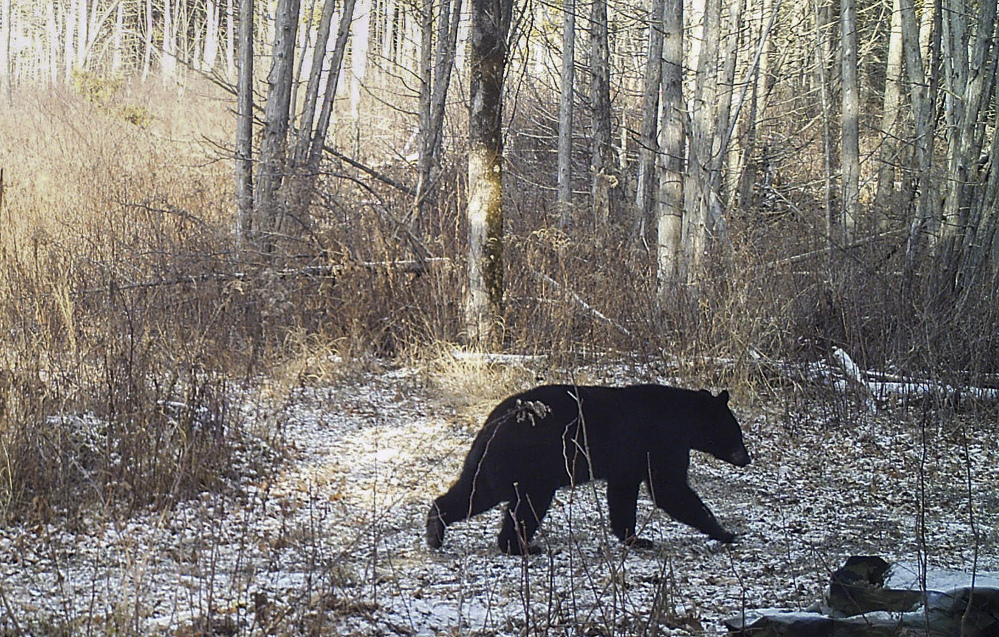MONTPELIER, Vt. — For now, the El Nino-driven mild weather is a boon to some wildlife, which are able to forage for more food and are using less energy surviving, experts say. But for some species – like snowshoe hares, whose white fur makes them conspicuous to predators – the lack of snow isn’t good news.
Access to food, such as nuts and apples, which have been abundant but are now getting scarce, has kept some black bears active and out of their winter dens. The bear activity has prompted officials in Vermont and Massachusetts to urge residents to wait for snow before putting up bird feeders to avoid attracting bears.
“We suggest waiting for 6 or more inches of snow that lasts before putting out your bird feeders, especially if you have been visited in the past by bears or if there are sightings of bears in your neighborhood,” Forrest Hammond, Vermont Fish and Wildlife’s bear biologist, said this week. “Due to lack of snow and frozen ground, birds are able to forage in fields and forests for their natural foods.”
Female bears typically go into their dens before males, he said. A lack of available food rather than cold weather tends to drive males into their dens, he said.
In Maine, the bears stayed out later than normal this year, but most seem to be denning up now, said Judy Camuso, director of wildlife for the Maine Department of Inland, Fisheries and Wildlife. In Colorado, which this week was blanketed with snow, bears started to hibernate on schedule this fall, according to Mat Robbins, spokesman for Colorado Parks and Wildlife.
The amount of snow also can affect how comfortable the bears are and likely the rate that they use up their accumulated fat while they hibernate, Hammond said.
“A lot of their den sites are laying there exposed to the elements now,” he said. “If we get a couple feet of good snow depth, then their dens are covered over completely. You wouldn’t know there was a bear ever there.”
Predators don’t know they are there, they are not exposed to the elements and they sleep much more soundly so they’re not using up as much of their fat reserves, he said.
The mild fall also has delayed the annual migration of some geese and other waterfowl, according to Geoff LeBaron, director of the Christmas Bird Count for the National Audubon Society. Some species that winter in the U.S. move with the weather, or just in advance of it, so geese and waterfowl, especially in the East, stay north for as long as they can in mild winters, he said. Once things start to freeze up and there’s snow cover, they’ll head south, he said.
Virginia, where the temperature is expected to hit 70 on Christmas, is not seeing as many migratory waterfowl – Canada geese, swans – as it normally does this time of year.
“Without that colder weather up north to push those birds down, the word is that it’s been slow,” said Lee Walker, spokesman for the Virginia Department of Game and Inland Fisheries.
A lack of snow also makes some animals more vulnerable to prey. Snowshoe hares and long- and short-tailed weasels have already molted and grown in their winter white coats, a process driven by length of daylight.
“If you’re a barred owl or a great horned owl or a hawk – you know, a red-tailed hawk – or a fox or a coyote or a fisher, everything that’s hooked in as a predator would love to have a snowshoe hare for dinner,” said Mark Scott, director of wildlife for the Vermont Fish and Wildlife Department.
Send questions/comments to the editors.



Success. Please wait for the page to reload. If the page does not reload within 5 seconds, please refresh the page.
Enter your email and password to access comments.
Hi, to comment on stories you must . This profile is in addition to your subscription and website login.
Already have a commenting profile? .
Invalid username/password.
Please check your email to confirm and complete your registration.
Only subscribers are eligible to post comments. Please subscribe or login first for digital access. Here’s why.
Use the form below to reset your password. When you've submitted your account email, we will send an email with a reset code.